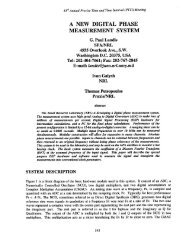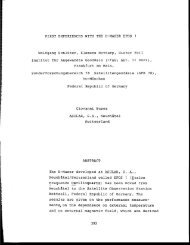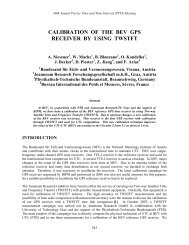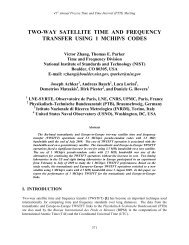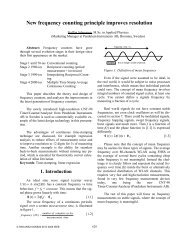allan variance estimated by phase noise measurements - PTTI
allan variance estimated by phase noise measurements - PTTI
allan variance estimated by phase noise measurements - PTTI
You also want an ePaper? Increase the reach of your titles
YUMPU automatically turns print PDFs into web optimized ePapers that Google loves.
36 th Annual Precise Time and Time Interval (<strong>PTTI</strong>) Meeting<br />
ALLAN VARIANCE ESTIMATED BY<br />
PHASE NOISE MEASUREMENTS<br />
P. C. Chang, H. M. Peng, and S. Y. Lin<br />
National Standard Time & Frequency Lab., TL, Taiwan<br />
12, Lane 551, Min-Tsu Road, Sec. 5, Yang-Mei, Taoyuan, Taiwan 326<br />
Tel: 886 3 424 5179, Fax: 886 3 424 5474, E-mail: betrand@cht.com.tw<br />
Abstract<br />
For short measurement times, the Allan (or two-sample) <strong>variance</strong> can be determined from<br />
the <strong>phase</strong> <strong>noise</strong> using the mathematical conversion between time and frequency domain. This<br />
provides us with a useful tool to obtain the very short-term frequency stability (τ
36 th Annual Precise Time and Time Interval (<strong>PTTI</strong>) Meeting<br />
FFT (Fast Fourier Transform) spectrum analyzer. The signal reference is from a SDI LNFR-400 low<strong>noise</strong><br />
frequency reference with a <strong>noise</strong> level of about –173 dBc/Hz (5 MHz PM, at Fourier frequency 100<br />
KHz). The system can measure up to –177 dBc/Hz for passive devices [4]. Recently, we improved the<br />
system using a cross-correlation technique, which enhances the measurement capability to measure the<br />
<strong>noise</strong> 15~20 dBc/Hz below the previous one. With Sy(f) from the <strong>phase</strong> <strong>noise</strong> measurement, getting the<br />
very-short-term frequency stability (τ < 0.5 sec.) in the time domain via time-frequency domain<br />
conversion is made possible. Adversely, it is not easy to measure the very-short-term frequency stability<br />
using a time-interval counter directly due to its resolution limitations. The traditional time-interval<br />
counter is applicable only when the sampling time τ is not smaller than 1 second.<br />
As for the mathematical conversion, two methods are adopted for comparison. The numerical integration,<br />
or trapezoidal integration to be precise, could calculate the Allan <strong>variance</strong> easily after the experimental<br />
data are properly processed. Besides, the power-law model is frequently used for describing the <strong>phase</strong><br />
<strong>noise</strong> and it assumes that the spectral density of normalized frequency fluctuations is equal to the sum of<br />
terms, each of which varies as an integer power of Fourier frequency f. Thus, there are two quantities that<br />
completely specify Sy(f) for a particular power-law process: the slope on a log-log plot for a given range<br />
of f and the amplitude. The slope is denoted <strong>by</strong> α and, therefore, f α is the straight line on a log-log plot<br />
that relates Sy(f) to f. The amplitude is denoted <strong>by</strong> hα. Therefore, Sy(f) can be represented <strong>by</strong> the addition<br />
of all the power-law processes with the appropriate coefficients:<br />
⎧<br />
⎪<br />
< <<br />
= ⎨<br />
⎪<br />
⎩<br />
><br />
∑+<br />
2<br />
α<br />
h αf<br />
for 0 f f h<br />
S y ( f ) α=<br />
−2<br />
(2)<br />
0 for f f h<br />
While 2πfhτ >> 1, Cutler derived equation (3) from equation (1) and (2):<br />
2<br />
h 1.<br />
038 + 3ln(<br />
2πf<br />
τ)<br />
σ y ( τ)<br />
+<br />
6<br />
2τ<br />
( 2π)<br />
τ<br />
2<br />
( 2π)<br />
0<br />
h<br />
h<br />
= h − 2 τ + h −1<br />
2ln<br />
2 + + h1<br />
h<br />
2 2<br />
2<br />
(3)<br />
2 2<br />
By properly determining the coefficients, the Allan <strong>variance</strong> with different τ could be obtained using<br />
Cutler’s equation. This could be achieved <strong>by</strong> locating each particular <strong>noise</strong> process in its dominant range<br />
of f with standard regression techniques.<br />
II. TESTS OF FIVE NOISE TYPES<br />
Before carrying out the mathematical conversion using the experimental results, we would like to know<br />
how each <strong>noise</strong> process behaves in this conversion. According to the power-law model, there are five<br />
types of <strong>noise</strong> processes, including Random Walk FM, Flicker FM, White FM, Flicker PM and White PM,<br />
with α equal to -2, -1, 0, +1, and +2 respectively. That means we need to generate five different Sy(f) for<br />
tests. For example, Sy(f) of the Random Walk FM <strong>noise</strong> process could be obtained <strong>by</strong> assuming the<br />
amplitude coefficient h-2 equal to 1×10 -26 with the rest equal to zero. The numerical integration and the<br />
power-law model are then used to calculate the Allan deviation (ADEV), that is, the square root of the<br />
Allan <strong>variance</strong>. With τ ranging from 1 millisecond to 10 seconds, the calculated ADEVs from both<br />
methods are shown in Figure 1 (a). It is obvious that while τ is smaller than 1 second, their ADEVs are in<br />
good agreement with each other. In this manner, Sy(f) of the other <strong>noise</strong> processes can be generated <strong>by</strong><br />
separately assuming h-1 = 1×10 -26 , h0 = 1×10 -26 , h+1 = 4×10 -28 , and h+2 = 3×10 -31 for the corresponding <strong>noise</strong><br />
processes and their ADEVs are shown in Figure 1 (b), (c), (d), and (e).<br />
166<br />
3f<br />
( 2π)<br />
τ
36 th Annual Precise Time and Time Interval (<strong>PTTI</strong>) Meeting<br />
It can be seen that for the <strong>noise</strong> processes of Flicker FM and White FM, the ADEV from both methods<br />
are in good agreement with each other while τ is smaller than 1 second; for Flicker PM, the ADEV from<br />
both methods match each other well in the whole range of τ, but for white PM, the results using the<br />
numerical integration vary up and down depending on τ, while the ones using the power-law model do<br />
not. Furthermore, only for some certain values of τ would the ADEV from both methods match each<br />
other well as to the last <strong>noise</strong> process.<br />
(a)<br />
(c)<br />
(e)<br />
Figure 1. The ADEV of five types of <strong>noise</strong> processes using the numerical<br />
integration and the power-law model. The sampling time τ is from 1<br />
millisecond to 10 seconds.<br />
167<br />
(b)<br />
(d)
36 th Annual Precise Time and Time Interval (<strong>PTTI</strong>) Meeting<br />
III. RESULTS AND CALCULATIONS<br />
Realizing how each individual <strong>noise</strong> process behaves in the conversion using these two methods, we try<br />
to convert the real <strong>phase</strong> <strong>noise</strong> measurement data into ADEV. Here we take the <strong>noise</strong> floor of our<br />
measurement system to be an example. A 5 MHz reference signal is split with a reactive splitter to<br />
provide a pair of input signals. These signals are connected to the LO and RF ports of a double-balanced<br />
mixer. A delay line unit is required here to put the two signals into quadrature (90° out of <strong>phase</strong>) before<br />
entering the mixer. The output of the mixer is low pass filtered, amplified, and then fed into a FFT<br />
spectrum analyzer.<br />
The spectral density of the system <strong>noise</strong> floor is shown in the upper graph of Figure 2. The Fourier<br />
frequency range is from 0.12 Hz to 99.75 kHz. There are some spur-like components appearing<br />
obviously in the graph, like <strong>noise</strong>s of 60 Hz, 120 Hz, 180 Hz, etc. It is clear that most of the outliers<br />
should arise from the ac power <strong>noise</strong>, which is always inevitably getting into the measurement system or<br />
the DUT. In order to check how much these spur-like components influence the calculation of the ADEV,<br />
we use the raw data and the outliers-removed data to calculate the ADEV and then compare them. The<br />
corrected spectral density of the system <strong>noise</strong> floor is shown in the lower graph of Figure 2.<br />
Figure 2. Spectral density of the system <strong>noise</strong> floor in Fourier frequency<br />
ranging from 0.12 Hz to 99.75 kHz. Upper graph: Spectral density consisting<br />
of spur-like periodic <strong>noise</strong>s, e.g. ac power <strong>noise</strong>. Lower graph: Outliers are<br />
removed from the spectral density.<br />
The measure L (f) on the y-axis is the prevailing expression of the <strong>phase</strong> <strong>noise</strong> among manufacturers and<br />
users of frequency standards. Its relation to Sy(f) can be expressed as:<br />
168
(4)<br />
36 th Annual Precise Time and Time Interval (<strong>PTTI</strong>) Meeting<br />
1 1 v0<br />
( f ) = Sφ<br />
( f ) = ( S 2<br />
2 2 f<br />
L y<br />
169<br />
2<br />
( f ))<br />
Sφ(f) is the spectral density of <strong>phase</strong> fluctuations and v0 is the carrier frequency. L (f) is usually reported<br />
in a dB format.<br />
dBc<br />
= 10 log ( L ( f ))<br />
Hz<br />
(5)<br />
After some calculations, the results from above-mentioned data using the numerical integration are shown<br />
in Figure 3. Roughly speaking, the spur-like components make the generated ADEV bigger than the<br />
other one, but because both of them vary up and down inconsistently, depending on τ, it is hard to<br />
precisely identify how much these spur-like components contribute to the ADEV.<br />
Figure 3. The ADEV calculated from the raw data with spur-like components and the<br />
outliers-removed data using the numerical integration. Both of them vary up and<br />
down inconsistently, depending on τ.<br />
The power-law model is not applicable here because the existence of spur-like components is not in its<br />
basic assumption. It is meaningless to fit the experimental data with the model. Nevertheless, we can<br />
still make the ADEV comparison with the outliers-removed data using the numerical integration and<br />
power-law model. In the lower graph of Figure 2, we see that when f increases <strong>by</strong> one decade, L (f) also<br />
goes down <strong>by</strong> one decade for f = 0.12 ~ 1000 Hz. The dominant <strong>noise</strong> process in this range can be<br />
regarded as Flicker PM. For f = 10 ~ 99.75 kHz, L (f) is almost the same, and the dominant <strong>noise</strong> process<br />
should be White PM. We use the functions h+1f and h+2f 2 to fit the data in the corresponding range and<br />
get h+1 = 4.68 × 10 -28 and h+2 = 2.61 × 10 -31 . With the help of Cutler’s equation, we can compare the<br />
generated ADEV with the one using the numerical integration, as shown in Figure 4.
36 th Annual Precise Time and Time Interval (<strong>PTTI</strong>) Meeting<br />
We observe that the results using the numerical integration vary up and down, depending on τ, while the<br />
ones using the power-law model do not. Furthermore, only for some certain values of τ would the ADEV<br />
from both methods match each other well. Since there are only two <strong>noise</strong> processes existent in the data, it<br />
seems to be a reasonable conclusion that the <strong>noise</strong> process of White PM in the data should be responsible<br />
for this observation, as shown in the previous tests of five <strong>noise</strong> types.<br />
Figure 4. The ADEV calculated from the outliers-removed data using the numerical<br />
integration and the power-law model. The former varies up and down, depending on<br />
τ, while the latter does not.<br />
IV. CONCLUSIONS<br />
In this paper, we use the <strong>phase</strong> <strong>noise</strong> data in our lab to calculate the ADEV via the time-frequency domain<br />
conversion. The numerical integration and Cutler’s equation derived from the power-law model are two<br />
methods adopted for comparison. We observe that for the <strong>noise</strong> processes of Random Walk FM, Flicker<br />
FM, White FM, and Flicker PM, the ADEV from both methods match each other well while τ is smaller<br />
than 1 second, but for White PM, the ADEV using the numerical integration varies up and down,<br />
depending on τ, while the one using the power-law model does not. This observation is shown both in the<br />
individual <strong>noise</strong> tests and the result from a real <strong>phase</strong> <strong>noise</strong> measurement. That means obtaining the veryshort-term<br />
frequency stability (τ < 0.5 second) in the time domain is possible if the discrepancy of the<br />
White PM calculation from the two methods can be resolved. Besides, as for the influence of ac power<br />
<strong>noise</strong>, it is hard to precisely identify how much these spur-like components contribute to the ADEV, also<br />
due to the influence of White PM using the numerical integration. In order to solve this problem, we will<br />
do more research in the near future.<br />
REFERENCES<br />
[1] Samuel R. Stein, 1985, “Frequency and Time - Their Measurement and Characterization,” Precision<br />
Frequency Control, Vol. 2, Chap. 12, pp. 203-204.<br />
170
36 th Annual Precise Time and Time Interval (<strong>PTTI</strong>) Meeting<br />
[2] “Characterization of Frequency and Phase Noise,” Report 580 of the International Radio<br />
Consultative Committee (C.C.I.R), pp. 142-150, 1986.<br />
[3] D. Allan, H. Hellwig, P. Kartaschoff, J. Vanier, J. Vig, G. M. R. Winkler, and N. Yannoni, 1988,<br />
“Standard Terminology for Fundamental Frequency and Time Metrology,” in Proceedings of the<br />
42 nd Annual Symposium on Frequency Control, 1-3 June 1988, Baltimore, Maryland, USA (IEEE<br />
88CH2588-2), pp. 419-425.<br />
[4] Femtosecond Systems, Inc., FSS1000E Phase Noise Detector FSS1011A Delay Line Operation<br />
Manual, Chap. 1.<br />
171
36 th Annual Precise Time and Time Interval (<strong>PTTI</strong>) Meeting<br />
QUESTIONS AND ANSWERS<br />
SAM STEIN (Timing Solutions Corporation): I am confused about the outliers. What is the nature of<br />
the outliers?<br />
PO-CHENG CHANG: They are the AC power influence.<br />
STEIN: They are dispersed?<br />
CHANG: Yes.<br />
172



